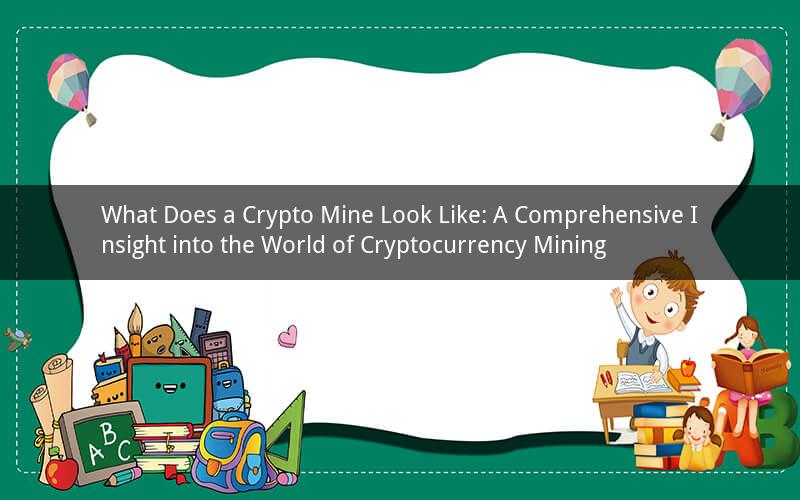
1. Introduction
The rise of cryptocurrencies has brought about a new era of digital finance. With the increasing popularity of digital currencies like Bitcoin, Ethereum, and Litecoin, more and more individuals are venturing into the world of cryptocurrency mining. But what exactly does a crypto mine look like? This article will provide an in-depth exploration of the world of crypto mining, covering everything from the hardware and software involved to the environmental impact and future of the industry.
2. The Basics of Crypto Mining
2.1 What is Crypto Mining?
Crypto mining is the process of validating and adding new transactions to a cryptocurrency's public ledger, known as a blockchain. Miners use powerful computers to solve complex mathematical problems, and in return, they are rewarded with cryptocurrency tokens.
2.2 Why Do People Mine Cryptocurrency?
People mine cryptocurrency for several reasons, including the potential for financial gain, the thrill of contributing to the blockchain network, and the desire to own a piece of the digital currency revolution.
3. The Hardware and Software Involved in Crypto Mining
3.1 Mining Hardware
Mining hardware is the heart of any crypto mine. The most popular type of mining hardware is the Application-Specific Integrated Circuit (ASIC), which is designed specifically for mining a particular cryptocurrency. Other types of mining hardware include Graphics Processing Units (GPUs) and Field-Programmable Gate Arrays (FPGAs).
3.2 Mining Software
Mining software is used to manage the mining process, including connecting to a mining pool, monitoring the performance of the hardware, and managing the rewards earned from mining. Some popular mining software includes CGMiner, BFGMiner, and EasyMiner.
4. The Crypto Mining Process
4.1 The Mining Process
The mining process involves solving complex mathematical problems to validate new transactions. Once a problem is solved, the miner is rewarded with cryptocurrency tokens. This process is known as Proof of Work (PoW), and it is the underlying technology that powers the majority of cryptocurrencies.
4.2 Mining Pools
Mining pools are groups of miners who work together to increase their chances of solving a mathematical problem and earning a reward. When a pool solves a problem, the rewards are distributed among the members based on the amount of computing power they contributed.
5. The Environmental Impact of Crypto Mining
5.1 The Energy Consumption of Crypto Mining
Crypto mining is an energy-intensive process that consumes a significant amount of electricity. The energy consumption of crypto mining has raised concerns about the environmental impact of the industry.
5.2 Efforts to Reduce the Environmental Impact
Many mining operations are working to reduce their environmental impact by using renewable energy sources and optimizing their hardware to consume less power.
6. The Future of Crypto Mining
6.1 The Evolution of Mining Hardware
As the difficulty of mining increases, miners are constantly seeking more efficient and powerful hardware. The evolution of mining hardware is likely to continue, with new technologies and innovations emerging to meet the demands of the industry.
6.2 The Potential for Blockchain Scaling
Blockchain scaling is a critical issue for the future of cryptocurrency mining. As the number of transactions on a blockchain increases, the time and energy required to validate those transactions also increases. Blockchain scaling solutions could significantly impact the future of crypto mining.
7. Conclusion
Crypto mining is a fascinating and rapidly evolving industry that plays a crucial role in the world of digital currencies. As the popularity of cryptocurrencies continues to grow, so too does the demand for efficient and sustainable mining operations. By understanding the hardware, software, and environmental impact of crypto mining, we can better appreciate the role it plays in shaping the future of digital finance.
8. Questions and Answers
Q1: What is the most energy-efficient mining hardware available today?
A1: The most energy-efficient mining hardware is typically the latest generation of ASIC miners, which are designed to solve complex mathematical problems with minimal energy consumption.
Q2: How does a mining pool work, and what are the benefits of joining one?
A2: A mining pool is a group of miners who work together to increase their chances of solving a mathematical problem and earning a reward. The benefits of joining a mining pool include a higher probability of earning rewards and the ability to spread out the costs of mining hardware.
Q3: What are the main environmental concerns associated with crypto mining?
A3: The main environmental concerns associated with crypto mining include the high energy consumption and the potential for pollution from the release of greenhouse gases and other harmful emissions.
Q4: How can crypto mining be made more sustainable?
A4: Crypto mining can be made more sustainable by using renewable energy sources, optimizing hardware to consume less power, and implementing energy-efficient cooling systems.
Q5: What are some of the biggest challenges facing the crypto mining industry?
A5: The biggest challenges facing the crypto mining industry include the increasing difficulty of mining, the high cost of mining hardware, and the potential for regulatory changes that could impact the industry's growth.